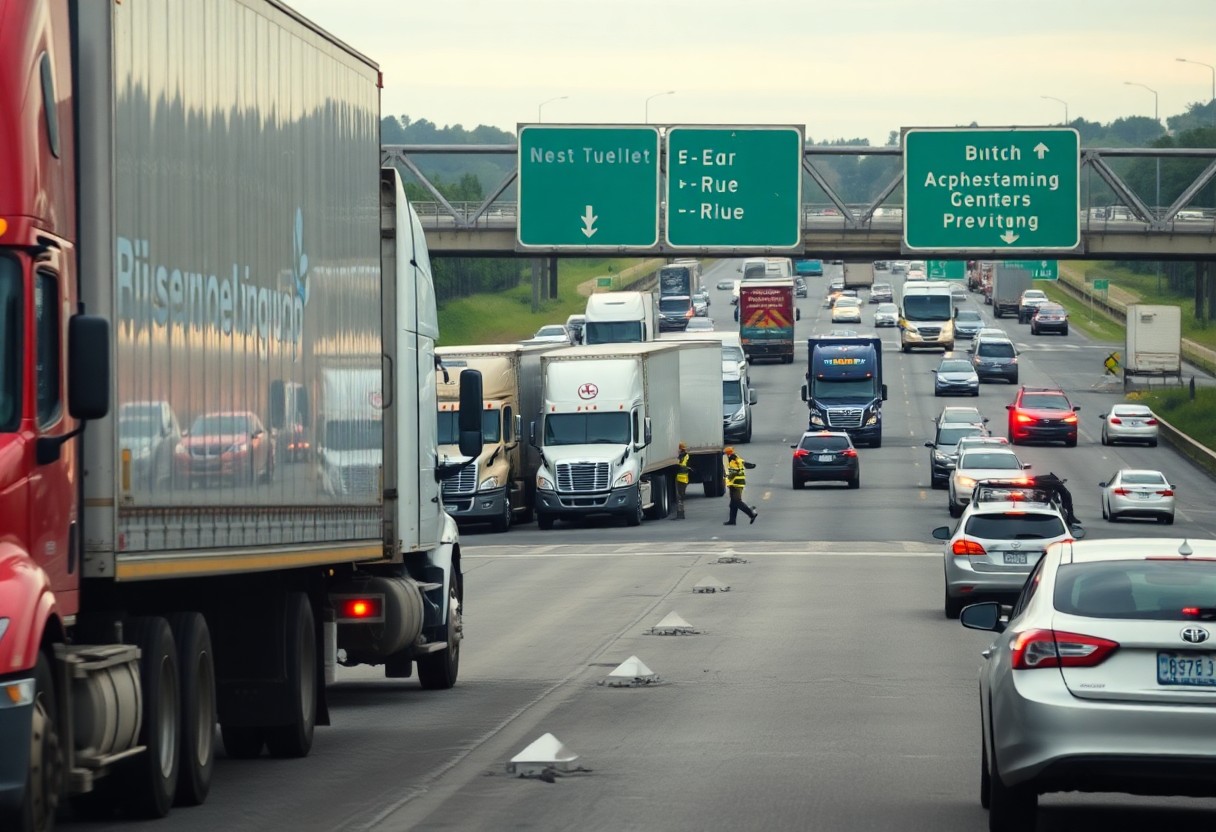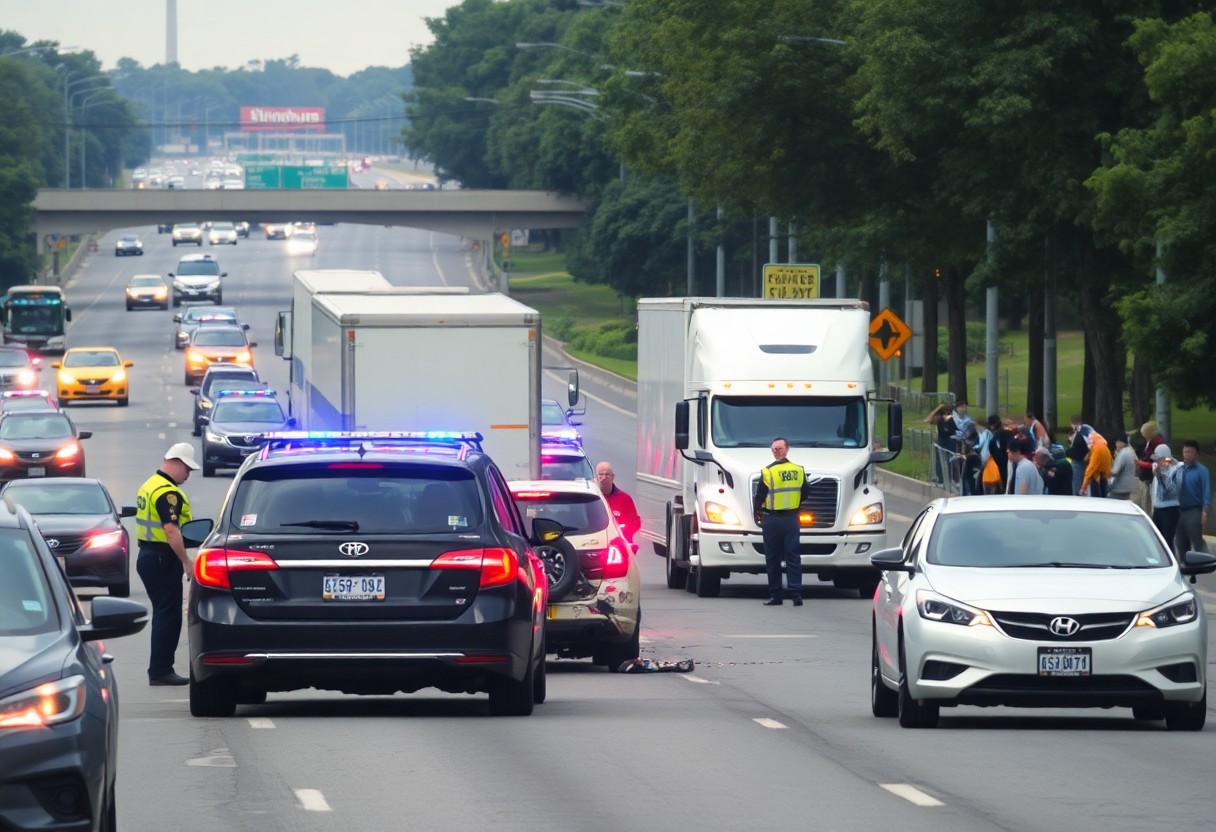You can significantly reduce the risk of accidents by understanding the blind spots of large trucks on Jacksonville’s roads. These expansive vehicles have areas that are difficult for drivers to see, particularly beside and behind them. By exercising caution and employing specific driving techniques, you can enhance your safety and that of others on the road. In this guide, we will provide you with vital tips for navigating around trucks effectively, ensuring a smoother and safer driving experience.
Understanding Blind Spots
For drivers navigating the roads of Jacksonville, it’s important to grasp the concept of blind spots, especially when sharing the road with large trucks. Blind spots are areas around a vehicle that the driver cannot see through mirrors or from their vantage point, often leading to dangerous situations if not understood and avoided.
What Are Blind Spots?
One of the primary challenges of driving is managing blind spots. These are areas where your view is obstructed, making it difficult to see other vehicles, pedestrians, or obstacles. In larger vehicles, like trucks, blind spots can be significantly larger, increasing the risk of accidents.
Blind Spot Zones Around Trucks
Understanding the blind spot zones around trucks is vital for your safety on the road. A truck typically has four main blind spots: one directly behind the vehicle, one directly in front, and large zones on both sides. The right side blind spot is often the largest, making it particularly dangerous if you attempt to overtake a truck on this side. Being aware of these zones can help you maintain a safe distance and avoid potential collisions.

How to Identify Potential Blind Spot Accidents
Some truck accidents can be prevented by identifying situations where blind spots may be present. Understanding how trucks operate and where their blind spots are located is vital for your safety on the road. Keep an eye out for large vehicles, especially in close proximity, as this can help you avoid positioning yourself in a truck’s blind spot.
Signs of a Blind Spot Risk
Blind spots can often be identified when large trucks are changing lanes or merging. If you notice a truck signaling to change lanes, be mindful of your position relative to the vehicle. If you can’t see the truck driver’s face in their side mirror, there’s a high chance you are in their blind spot.
Importance of Awareness
Risk of accidents increases significantly when you’re not aware of your surroundings. Staying alert to other vehicles, especially large trucks, is vital for protecting yourself and others. By understanding the dynamics of trucks and their blind spots, you can make informed decisions that keep you safe. Being aware of your position on the road will allow you to maintain a safe distance and avoid dangerous encounters.
For instance, if you notice a large truck alongside you, check your mirrors to ensure you are not in their blind spot. Taking just a moment to assess your surroundings can mean the difference between a safe driving experience and a potential accident. Being proactive in checking for blind spots not only helps you avoid collision but also promotes a safer driving environment for everyone on the road.
Tips for Drivers to Avoid Blind Spot Accidents
One of the key strategies to prevent blind spot accidents with trucks is to stay vigilant while driving. Here are some tips to enhance your safety:
- Always check your blind spots before changing lanes.
- Use your turn signals to communicate your intentions.
- Maintain a safe distance from trucks and other large vehicles.
- Avoid lingering in a truck’s blind spot.
Assume that large vehicles often have limited visibility, and take proactive measures to keep yourself safe.
Safe Distance Maintenance
With safe distance maintenance, you create an crucial buffer between your vehicle and trucks. By keeping a minimum of three car lengths behind a truck, you give yourself ample time to react. This distance not only helps you see traffic signals and sudden stops better, but it also reduces the risk of being caught in a blind spot. Always approach large vehicles with caution, especially in heavy traffic or adverse weather conditions.
Use of Mirrors and Technology
Some drivers may underestimate the value of utilizing mirrors and technology to monitor their surroundings. Make it a habit to regularly check your side mirrors and rearview mirror. Many modern vehicles come equipped with advanced safety features like blind-spot monitoring systems that alert you to nearby vehicles. Utilizing these features can significantly lower your risk of being involved in an accident.
Tips for enhancing your use of mirrors and technology include adjusting your mirrors to minimize blind spots and keeping them clean for maximum visibility. Furthermore, consider investing in additional safety gear, like backup cameras and lane departure warnings, which can provide crucial insights about your surroundings. Always ensure that your mirrors are properly positioned and that you utilize all available technological aids to maintain awareness of your surroundings and help avoid dangerous situations.
Factors Influencing Blind Spot Risks
To reduce the likelihood of blind spot accidents with trucks in Jacksonville, AL, you must consider several important factors that influence blind spot risks, such as:
- Truck size and design
- Driver behavior and experience
- Road conditions
- Your own vehicle’s position
Assume that understanding these elements will enhance your driving awareness and help prevent potential collisions.
Truck Size and Design
Some trucks have larger blind spots due to their size and design, making it necessary for you to recognize these zones while driving. Trucks like semis often have significant areas where drivers can’t see smaller vehicles, particularly on the sides and rear. Being aware of the size of the truck can help you adjust your distance accordingly.
Driver Behavior and Experience
Assuming that drivers of large trucks possess varying levels of experience, their behavior on the road can greatly impact blind spot safety. An experienced truck driver may navigate more safely and adeptly manage their blind spots, while a novice driver may be less cautious, increasing risks for surrounding vehicles.
Behavior plays a significant role in preventing accidents. Distracted driving, such as texting or adjusting controls, greatly elevates the risk of blind spot incidents. Conversely, attentive and proactive drivers significantly reduce the likelihood of accidents. It’s necessary for you to be mindful of truck drivers’ actions and anticipate their movement when in proximity, maintaining a safe distance and avoiding abrupt lane changes.
Defensive Driving Techniques
After understanding the importance of remaining vigilant around large trucks, practicing defensive driving techniques can significantly reduce your risk of accidents. Always maintain a safe distance, adjust your speed according to the traffic conditions, and stay aware of your surroundings. Being proactive, rather than reactive, helps you anticipate potential hazards and make safer decisions on the road.
Anticipating Truck Movements
An vital aspect of defensive driving is anticipating truck movements. Large trucks require more time and space to maneuver, especially when turning or changing lanes. By staying alert and observing the truck’s signals, you can foresee when the truck may slow down or make a sudden maneuver, allowing you to react appropriately and avoid collisions.
Making Safe Lane Changes
Truck drivers have limited visibility, making it imperative for you to execute safe lane changes. Always use your turn signals and check your mirrors thoroughly; trucks need more time to stop, so allow ample space when merging. Ensure that there is enough visibility to see the truck’s position, and don’t cut in too close after changing lanes.
Making safe lane changes is vital for keeping everyone on the road protected. Always signal your intentions well in advance and check your blind spots carefully before merging. Allocate extra space between your vehicle and large trucks, understanding that they may require a full lane to maneuver. Avoid lingering alongside the truck; instead, move ahead or fall back to limit any potential risks. By following these guidelines, you enhance safety for both yourself and the truck driver, drastically reducing the chance of an accident.
Educating Others on Blind Spot Safety
Your awareness and knowledge can greatly impact road safety. By educating others about the hazards associated with truck blind spots, you can help create a safer driving environment. Sharing vital information and tips can not only protect lives but also foster a sense of responsibility among drivers in Jacksonville, AL.
Sharing Knowledge with Peers
Blind spots are often overlooked, creating dangerous situations on the road. By discussing blind spot safety with your peers, you can cultivate a culture of safety in your community. Encourage friends and family to stay informed by sharing articles, hosting discussions, or even organizing informal workshops.
Importance of Community Awareness
Spotting the dangers of blind spots is important for every driver, and building community awareness can make all the difference. With a collective effort from everyone, you can raise awareness about the size and location of a truck’s blind spots, fostering better driving habits. Engaging in discussions, attending local safety events, and utilizing social media can amplify your message, leading to a more cautious driving culture. By uniting as a community, you can significantly decrease the risk of accidents, ensuring safer roads for all in Jacksonville, AL.
Conclusion
Following this guide, you can significantly reduce the risk of blind spot accidents with trucks in Jacksonville, AL. Stay aware of your surroundings, always check your mirrors, and maintain safe following distances. When changing lanes, take the extra moment to double-check for trucks in your blind spots. Educating yourself about truck visibility can protect not only your life but also the lives of others on the road. By practicing these safety tips, you contribute to a safer driving environment for everyone.



















